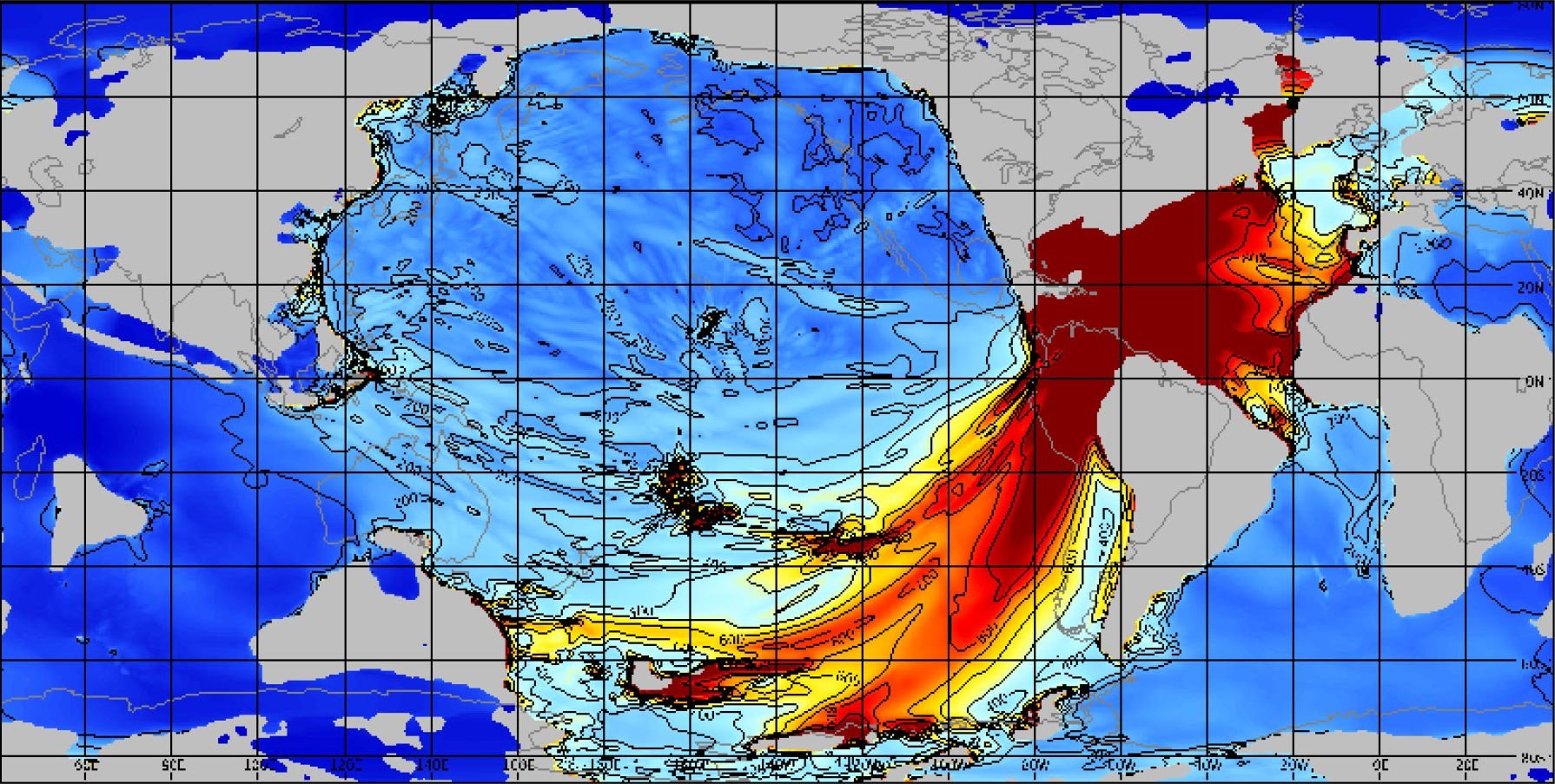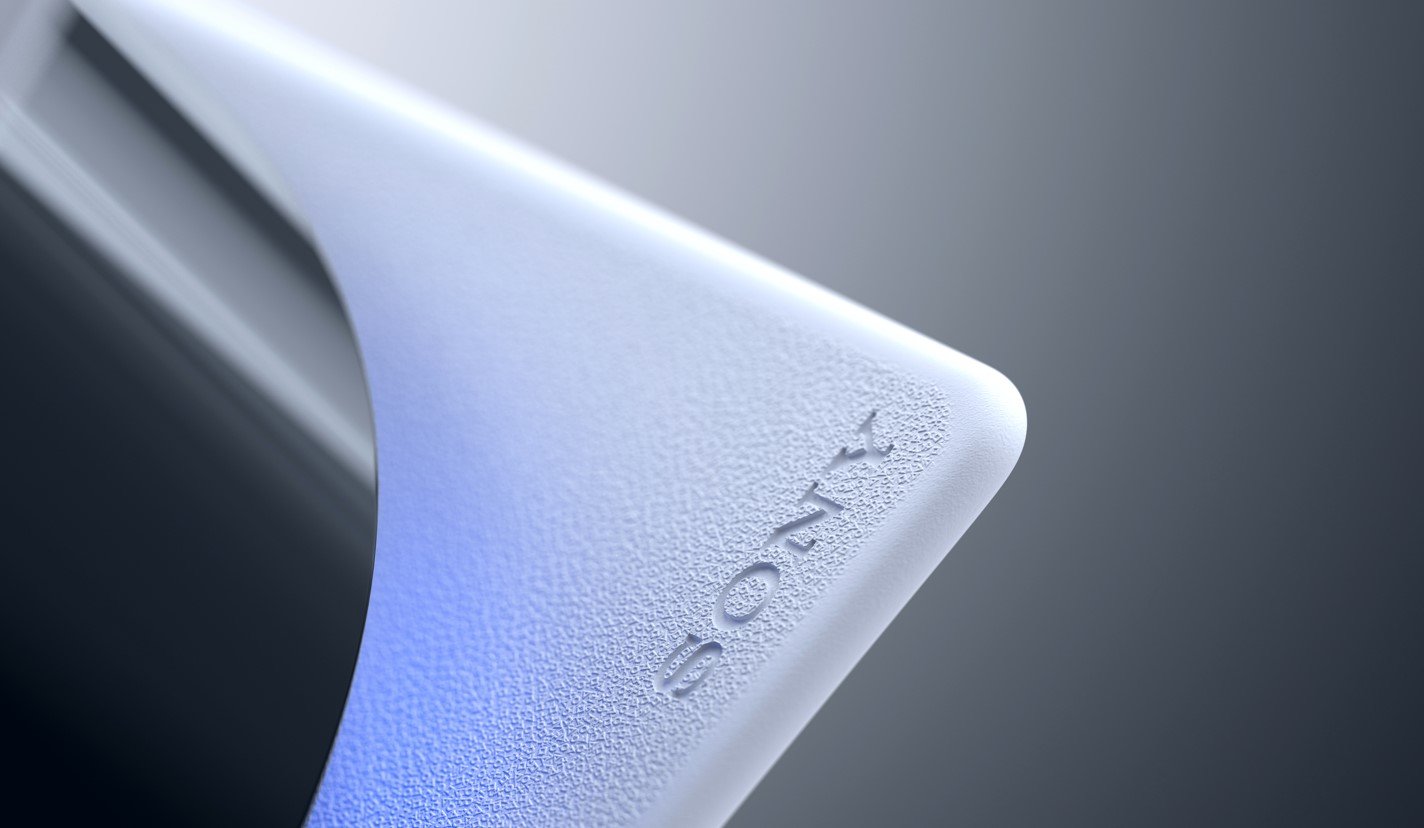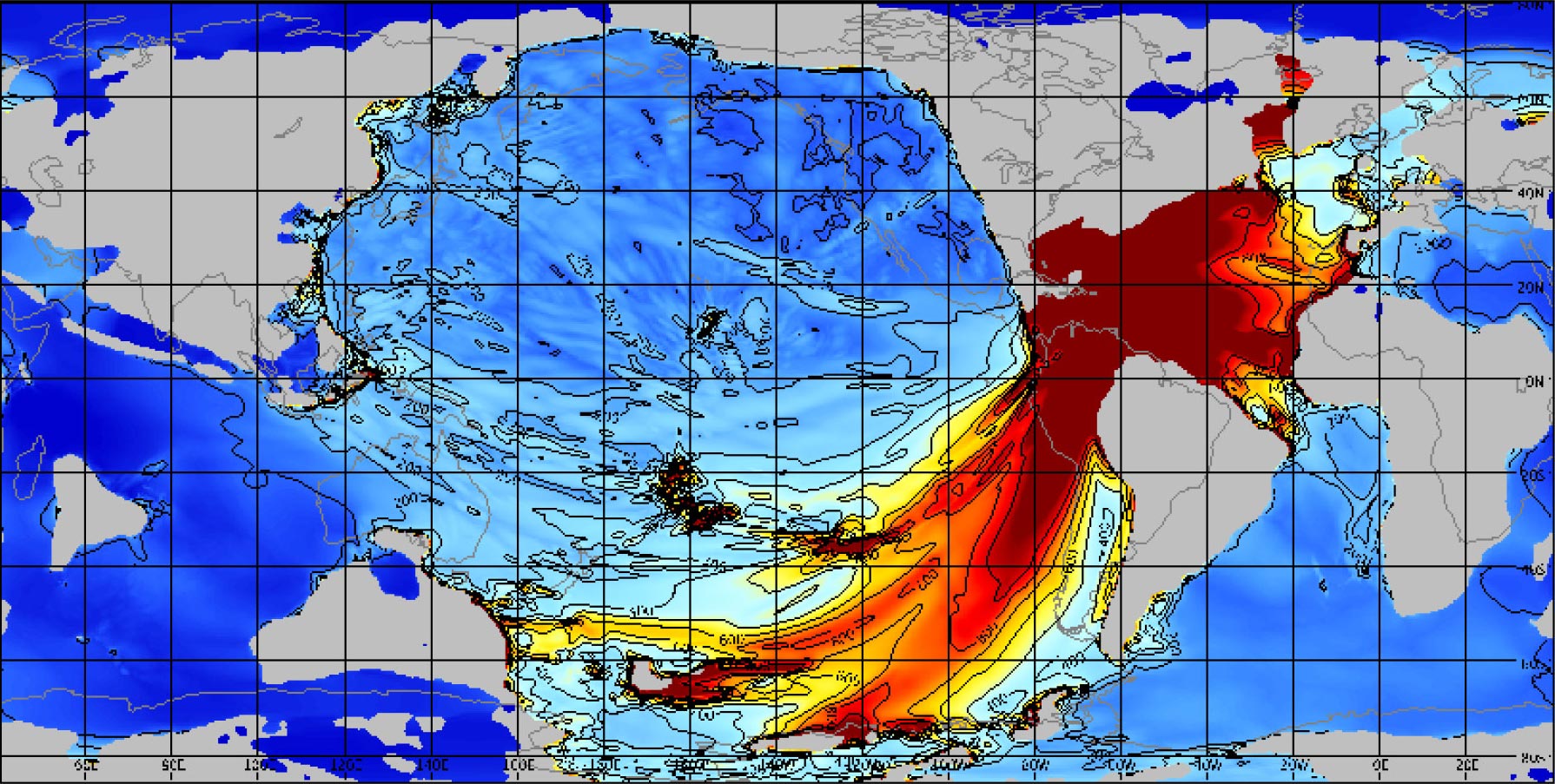
السعة القصوى لموجة تسونامي بعد اصطدام كويكب قبل 66 مليون سنة. الائتمان: Range et al. AGU Advance ، في عام 2022
منذ ستة وستين مليون سنة ، ضرب كويكب بعرض ميل الأرض ، مما أدى إلى القضاء على جميع الديناصورات تقريبًا وثلاثة أرباع الأنواع النباتية والحيوانية على كوكب الأرض.
تسببت في حدوث تسونامي مدمر مع موجات يبلغ ارتفاعها ميلًا اجتاحت قاع المحيط لآلاف الأميال من نقطة التأثير على شبه جزيرة يوكاتان المكسيكية ، وفقًا لدراسة جديدة قادتها جامعة ميشيغان ، نُشرت على الإنترنت في 4 أكتوبر في المجلة. السلف AGU.
تنشر الدراسة البحثية أول محاكاة عالمية لتسونامي اصطدام تشيكسولوب في مجلة علمية محكمة. بالإضافة إلى ذلك ، راجع علماء UM السجل الجيولوجي في أكثر من 100 موقع في جميع أنحاء العالم ووجدوا أدلة تدعم تنبؤات نماذجهم حول مسار تسونامي وقوته.
وقالت المؤلفة الرئيسية مولي رينج “كان هذا التسونامي قويًا بما يكفي لإزعاج وتآكل الرواسب في أحواض المحيطات حول العالم ، تاركًا فجوة في السجل الرسوبي أو خليطًا من الرواسب القديمة”. أجرت دراسة النمذجة لأطروحة الماجستير الخاصة بها تحت إشراف عالم المحيطات الفيزيائية بجامعة UM والمؤلف المشارك للدراسة Brian Orbick و UM Paleoceanographer والمؤلف المشارك في الدراسة Ted Moore.
https://www.youtube.com/watch؟v=hy6wfjqFBE0
تأثير الطاقة
ركز تحليل السجل الجيولوجي على “الأجزاء الحدودية”. هذه هي الرواسب البحرية التي ترسبت قبل وقت قصير من اصطدام الكويكب أو بعده[{” attribute=””>Cretaceous–Paleogene (K-Pg) mass extinction, which closed the Cretaceous Period.
“The distribution of the erosion and hiatuses that we observed in the uppermost Cretaceous marine sediments are consistent with our model results, which gives us more confidence in the model predictions,” said Range, who started the project as an undergraduate in Arbic’s lab in the Department of Earth and Environmental Sciences.
According to the study’s calculations, the initial energy in the impact tsunami was up to 30,000 times larger than the energy in the December 2004 Indian Ocean earthquake tsunami. That one is one of the largest tsunamis in the modern record and killed more than 230,000 people.

Modeled tsunami sea-surface height perturbation, in meters, four hours after the asteroid impact. This image shows results from the MOM6 model, one of two tsunami-propagation models used in the University of Michigan-led study. Credit: From Range et al. in AGU Advances, 2022
The researcher’s simulations show that the impact tsunami radiated mainly to the east and northeast into the North Atlantic Ocean, and to the southwest into the South Pacific Ocean through the Central American Seaway (which used to separate North America and South America).
In those basins and in some adjacent areas, underwater current speeds likely exceeded 20 centimeters per second (0.4 mph),. This velocity is powerful enough to erode fine-grained sediments on the seafloor.
In contrast, the South Atlantic, the North Pacific, the Indian Ocean, and the region that is today the Mediterranean were largely shielded from the strongest effects of the tsunami, according to the team’s simulation. In those places, the modeled current speeds were likely less than the 20 cm/sec threshold.
Geological corroboration
U-M’s Moore analyzed published records of 165 marine boundary sections for the review of the geological record. He was able to obtain usable information from 120 of them. Most of the sediments came from cores collected during scientific ocean-drilling projects.
The North Atlantic and South Pacific had the fewest locations with complete, uninterrupted K-Pg boundary sediments. In contrast, the largest number of complete K-Pg boundary sections were uncovered in the South Atlantic, the North Pacific, the Indian Ocean, and the Mediterranean.

Modeled tsunami sea-surface height perturbation, in meters, 24 hours after the asteroid impact. This image shows results from the MOM6 model, one of two tsunami-propagation models used in the University of Michigan-led study. Credit: From Range et al. in AGU Advances, 2022
“We found corroboration in the geological record for the predicted areas of maximal impact in the open ocean,” said Arbic. He is a professor of earth and environmental sciences and oversaw the project. “The geological evidence definitely strengthens the paper.”
Of special significance, according to the authors, are outcrops of the K-Pg boundary on the eastern shores of New Zealand’s north and south islands, which are more than 7,500 miles (12,000 kilometers) from the Yucatan impact site.
The heavily disturbed and incomplete New Zealand sediments, called olistostromal deposits, were originally thought to be the result of local tectonic activity. However, given the age of the deposits and their location directly in the modeled pathway of the Chicxulub impact tsunami, the U-M-led team of researchers suspects a different origin.
“We feel these deposits are recording the effects of the impact tsunami, and this is perhaps the most telling confirmation of the global significance of this event,” Range said.
Comparing models
The modeling portion of the study used a two-stage strategy. First, a large computer program called a hydrocode simulated the chaotic first 10 minutes of the event. This included the asteroid impact, crater formation, and initiation of the tsunami. That work was conducted by co-author Brandon Johnson of Purdue University.
Based on the findings of previous studies, the scientists modeled an asteroid that was 8.7 miles (14 kilometers) in diameter, moving at 27,000 mph (12 kilometers per second). It struck granitic crust overlain by thick sediments and shallow ocean waters, blasting an approximately 62-mile-wide (100-kilometer-wide) crater and ejecting dense clouds of soot and dust into the atmosphere.

Maximum tsunami wave amplitude, in centimeters, following the asteroid impact 66 million years ago. Credit: From Range et al. in AGU Advances, 2022
Two and a half minutes after the asteroid struck, a curtain of ejected material pushed a wall of water outward from the impact site, briefly forming a 2.8-mile-high (4.5-kilometer-high) wave that subsided as the ejecta fell back to Earth.
According to the U-M simulation, 10 minutes after the projectile hit the Yucatan, and 137 miles (220 kilometers) from the point of impact, a 0.93-mile-high (1.5-kilometer-high) tsunami wave—ring-shaped and outward-propagating—began sweeping across the ocean in all directions.
At the 10-minute mark, the results of Johnson’s iSALE hydrocode simulations were entered into two tsunami-propagation models, MOM6 and MOST, to track the giant waves across the ocean. MOM6 has been used to model tsunamis in the deep ocean, and NOAA uses the MOST model operationally for tsunami forecasts at its Tsunami Warning Centers.
“The big result here is that two global models with differing formulations gave almost identical results, and the geologic data on complete and incomplete sections are consistent with those results,” said Moore, professor emeritus of earth and environmental sciences. “The models and the verification data match nicely.”
According to the team’s simulation:
- One hour after impact, the tsunami had spread outside the Gulf of Mexico and into the North Atlantic.
- Four hours after impact, the waves had passed through the Central American Seaway and into the Pacific.
- Twenty-four hours after impact, the waves had crossed most of the Pacific from the east and most of the Atlantic from the west and entered the Indian Ocean from both sides.
- By 48 hours after impact, significant tsunami waves had reached most of the world’s coastlines.
Dramatic wave heights
For the current study, the research team did not attempt to estimate the extent of coastal flooding caused by the tsunami.
However, their models indicate that open-ocean wave heights in the Gulf of Mexico would have exceeded 328 feet (100 meters), with wave heights of more than 32.8 feet (10 meters) as the tsunami approached North Atlantic coastal regions and parts of South America’s Pacific coast.
As the tsunami neared those shorelines and encountered shallow bottom waters, wave heights would have increased dramatically through a process called shoaling. Current speeds would have exceeded the 0.4 mph (20 centimeters per second) threshold for most coastal areas worldwide.
“Depending on the geometries of the coast and the advancing waves, most coastal regions would be inundated and eroded to some extent,” according to the researchers. “Any historically documented tsunamis pale in comparison with such global impact.”
The follow-up
Arbic said that a follow-up study is planned to model the extent of coastal inundation worldwide. That study will be led by Vasily Titov of the National Oceanic and Atmospheric Administration’s Pacific Marine Environmental Lab, who is a co-author of the AGU Advances paper.
Reference: “The Chicxulub Impact Produced a Powerful Global Tsunami” by Molly M. Range, Brian K. Arbic, Brandon C. Johnson, Theodore C. Moore, Vasily Titov, Alistair J. Adcroft, Joseph K. Ansong, Christopher J. Hollis, Jeroen Ritsema, Christopher R. Scotese and He Wang, 4 October 2022, AGU Advances.
DOI: 10.1029/2021AV000627
In addition to Range, Arbic, Moore, Johnson and Titov, the study authors are Alistair Adcroft of Princeton University, Joseph Ansong of the University of Ghana, Christopher Hollis of Victoria University of Wellington, Jeroen Ritsema of the University of Michigan, Christopher Scotese of the PALEOMAP Project, and He Wang of NOAA’s Geophysical Fluid Dynamics Laboratory and the University Corporation for Atmospheric Research.
Funding was provided by the National Science Foundation and the University of Michigan Associate Professor Support Fund, which is supported by the Margaret and Herman Sokol Faculty Awards. The MOM6 simulations were carried out on the Flux supercomputer provided by the University of Michigan Advanced Research Computing Technical Services.

“متعصب التلفزيون. مدمن الويب. مبشر السفر. رجل أعمال متمني. مستكشف هواة. كاتب.”







More Stories
خريطة جديدة للمريخ تكشف عن “هياكل” مخفية تحت سطح المريخ
زوج من نفاثات البلازما الضخمة تندلع من ثقب أسود هائل | الثقوب السوداء
الأسمنت المستوحى من عظام الإنسان أصعب بخمس مرات من الخرسانة العادية